重要研究成果
羅佩凌 博士
(2024)
J. Phys. Chem. Lett.,15, 3733–3739 (2024)
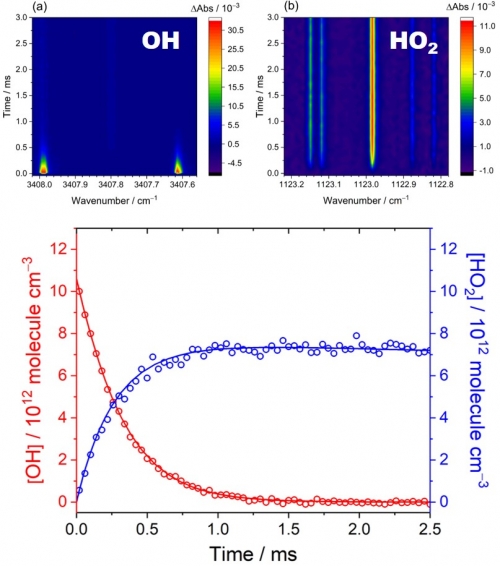
The radical–radical reaction between OH and HO2 has been considered for a long time as an important reaction in tropospheric photochemistry and combustion chemistry. However, a significant discrepancy of an order of magnitude for rate coefficients of this reaction is found between two recent experiments. Herein, we investigate the reaction OH + HO2 via direct spectral quantification of both the precursor (H2O2) and free radicals (OH and HO2) upon the 248 nm photolysis of H2O2 using infrared two-color time-resolved dual-comb spectroscopy. With quantitative and kinetic analysis of concentration profiles of both OH and HO2 at varied conditions, the rate coefficient kOH+HO2 is determined to be (1.10 ± 0.12) × 10–10 cm3 molecule–1 s–1 at 296 K. Moreover, we explore the kinetics of this reaction under conditions in the presence of water, but no enhancement in the kOH+HO2 can be observed. This work as an independent experiment plays a crucial role in revisiting this prototypical radical–radical reaction.
任祥華 博士, 陳應誠 博士
(2024)
Quantum Sci. Tech. 9, 025020 (2024).
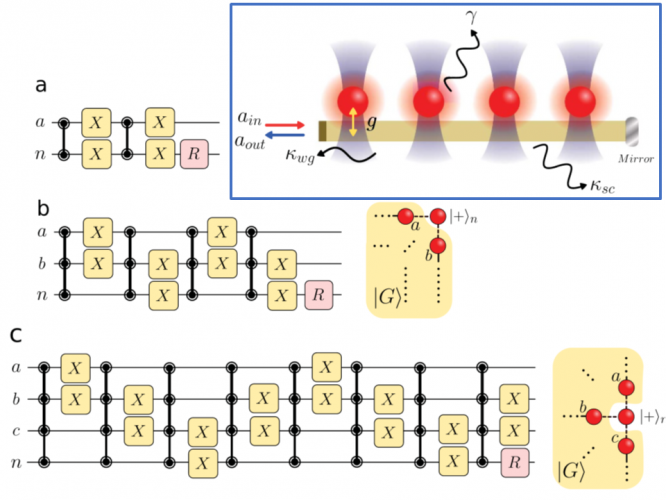
Scalable graph states are essential for measurement-based quantum computation and many entanglement-assisted applications in quantum technologies. Generation of these multipartite entangled states requires a controllable and efficient quantum device with delicate design of generation protocol. Here we propose to prepare high-fidelity and scalable graph states in one and two dimensions, which can be tailored in an atom-nanophotonic cavity via state carving technique. We propose a systematic protocol to carve out unwanted state components, which facilitates scalable graph states generations via adiabatic transport of a definite number of atoms in optical tweezers. An analysis of state fidelity is also presented, and the state preparation probability can be optimized via multiqubit state carvings and sequential single-photon probes. Our results showcase the capability of an atom-nanophotonic interface for creating graph states and pave the way toward novel problem-specific applications using scalable high-dimensional graph states with stationary qubits.
張煥正 博士
(2023)
Nano Lett. 23, 9811–9816 (2023).
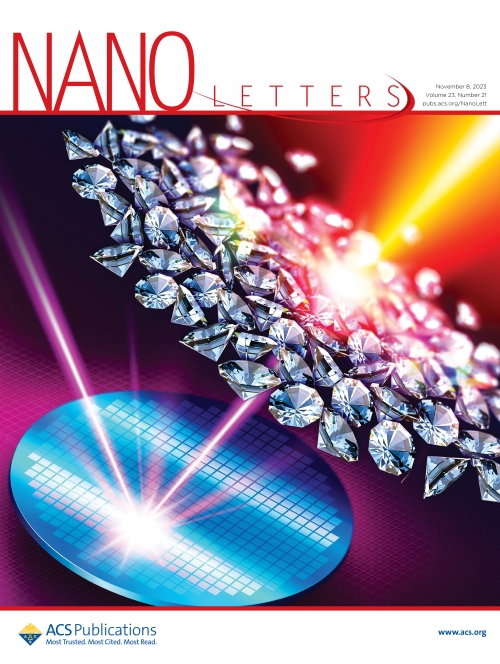
Extreme ultraviolet (EUV) radiation with wavelengths of 10 – 121 nm has drawn considerable attention recently for its use in photolithography to fabricate nanoelectronic chips. This study demonstrates, for the first time, fluorescent nanodiamonds (FNDs) with nitrogen-vacancy (NV) centers as scintillators to image and characterize EUV radiations. The FNDs employed are ~100 nm in size; they form a uniform and stable thin film on an indium tin oxide-coated slide by electrospray deposition. The film is non-hygroscopic, photostable, and can emit bright red fluorescence from NV0 centers when excited by EUV light. An FND-based imaging device has been developed and applied for beam diagnostics of 50 nm and 13.5 nm synchrotron radiations, achieving a spatial resolution of 30 μm using a film of ~1 μm thickness. The noise equivalent power density is 29 μW/cm2Hz1/2 for the 13.5 nm radiation. The method is generally applicable to imaging EUV radiations from different sources.
羅佩凌 博士
(2023)
Communications Chemistry, 6, 130 (2023)
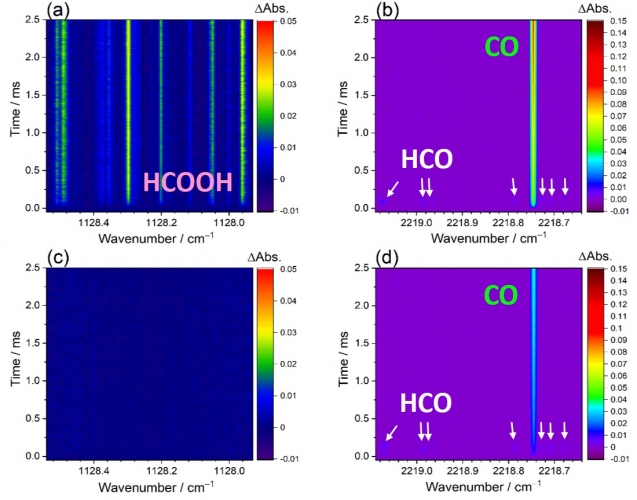
Ozonolysis of isoprene is considered to be an important source of formic acid (HCOOH), but its underlying reaction mechanisms related to HCOOH formation are poorly understood. Here, we report the kinetic and product studies of the reaction between the simplest Criegee intermediate (CH2OO) and formaldehyde (HCHO), both of which are the primary products formed in ozonolysis of isoprene. By utilizing time-resolved infrared laser spectrometry with the multifunctional dual-comb spectrometers, the rate coefficient kCH2OO+HCHO is determined to be (4.11 ± 0.25) × 10−12 cm3 molecule−1 s−1 at 296 K and a negative temperature dependence of the rate coefficient is observed and described by an Arrhenius expression with an activation energy of (–1.81 ± 0.04) kcal mol−1. Moreover, the branching ratios of the reaction products HCOOH + HCHO and CO + H2O + HCHO are explored. The yield of HCOOH is obtained to be 37–54% over the pressure (15–60 Torr) and temperature (283–313 K) ranges. The atmospheric implications of the reaction CH2OO + HCHO are also evaluated by incorporating these results into a global chemistry-transport model. In the upper troposphere, the percent loss of CH2OO by HCHO is found by up to 6% which can subsequently increase HCOOH mixing ratios by up to 2% during December-January-February months.
許良彥 博士
(2023)
J. Phys. Chem. Lett. 14, 25, 5924–5931 (2023).
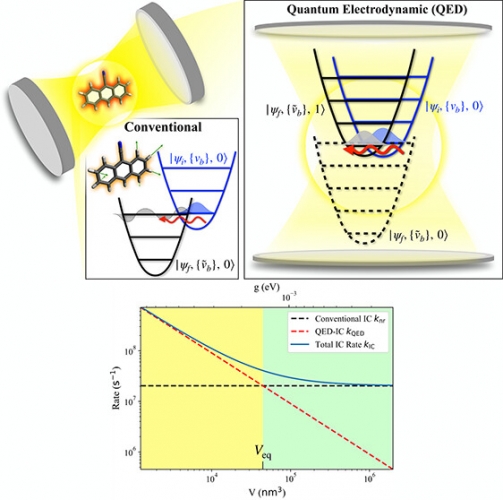
To explore non-adiabatic effects caused by electromagnetic (EM) vacuum fluctuations in molecules, we develop a general theory of internal conversion (IC) in the framework of quantum electrodynamics and propose a new mechanism, “quantum electrodynamic internal conversion” (QED-IC). The theory allows us to compute the rates of the conventional IC and QED-IC processes at the first-principles level. Our simulations manifest that, under experimentally feasible weak light–matter coupling conditions, EM vacuum fluctuations can significantly affect IC rates by an order of magnitude. Moreover, our theory elucidates three key factors in the QED-IC mechanism: the effective mode volume, coupling-weighted normal mode alignment, and molecular rigidity. The theory successfully captures the nucleus–photon interaction in the factor “coupling-weighted normal mode alignment”. In addition, we find that molecular rigidity plays a totally different role in conventional IC versus QED-IC rates. Our study provides applicable design principles for exploiting QED effects on IC processes.
目前位置:關於本所 / 重要研究成果 / 第 1 頁
中央研究院 原子與分子科學研究所版權所有 |
個人隱私權聲明 |
保有個資檔案公開項目彙整表 |
行動版
地址: 106319 台北市羅斯福路四段一號 或 106923 臺北臺大郵局 第23-166號信箱
電話:886-2-2362-0212 傳真:886-2-2362-0200 電子郵件:iamspublic@gate.sinica.edu.tw
最後更新於 2024-04-19 09:18:44
地址: 106319 台北市羅斯福路四段一號 或 106923 臺北臺大郵局 第23-166號信箱
電話:886-2-2362-0212 傳真:886-2-2362-0200 電子郵件:iamspublic@gate.sinica.edu.tw
最後更新於 2024-04-19 09:18:44
 中央研究院 原子與分子科學研究所
中央研究院 原子與分子科學研究所
